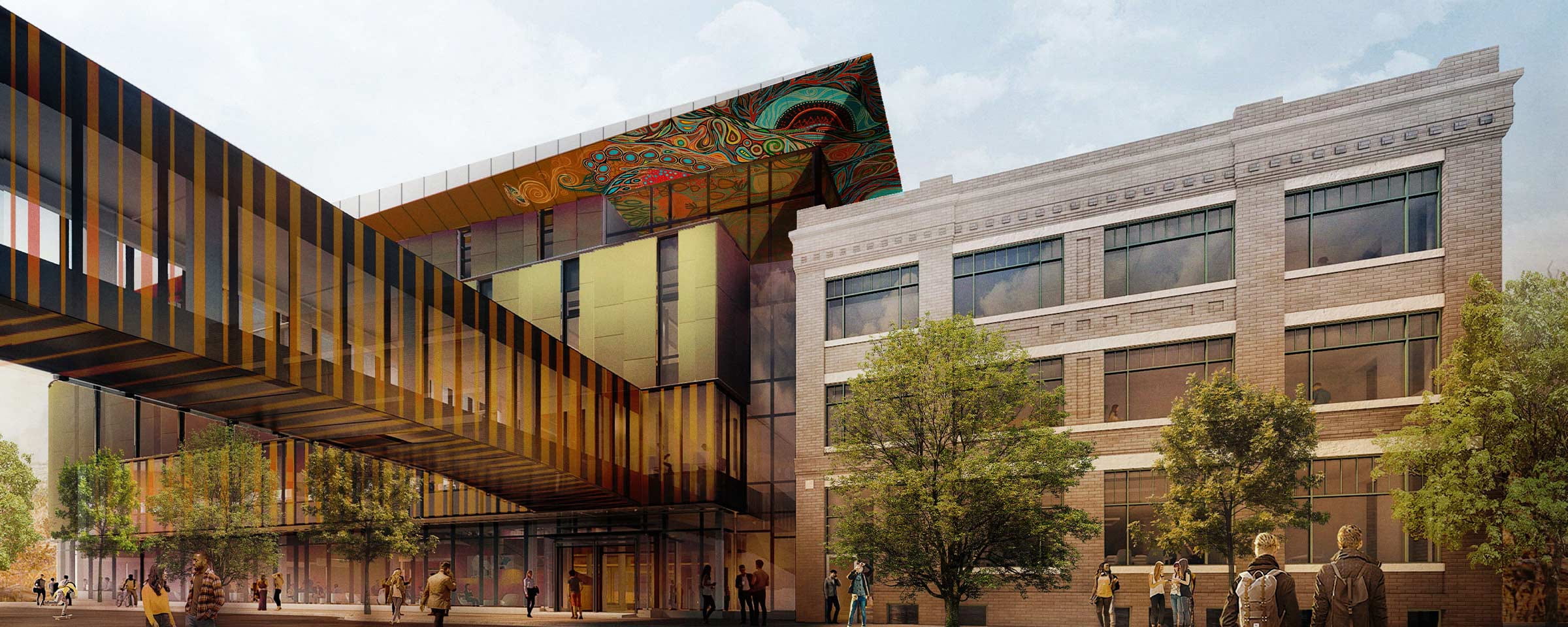


Manitou a bi Bii daziigae (in Anishinaabemowin (Ojibwe)) is RRC Polytech’s expansion of the Exchange District Campus, and the first RRC Polytech building to receive an Indigenous name. Manitou a bi Bii daziigae was previously known as the Innovation Centre project.
Pronunciation: Manitou a bi Bii daziigae – Anishinaabemowin (Ojibwe)
Man-a-too ah be • Bee da-zee-gae
Each Elder brings with them a lifetime of experiences, stories, ceremonial gifts, and lessons they’ve collected; each a rarity unto themselves. We recognize these distinct perspectives are not all-encompassing of Indigenous beliefs and ways of knowing, but represent microcosms of many nations on these lands that have created layers of organizational and belief system shifts at RRC Polytech.
“We’re in a time of beautiful change to bring that light, that hope. I think if we can bring that spirit of that name into that building, maybe we’ll be able to take that step ahead and walk with it. The new building is so unique. It’s powered by nature. Much like how we live, powered by nature and the sun. The sun is such a beautiful spirit; it brings warmth, it brings growth, it brings light, it brings hope. Without that sun there is no life. And if you look at the new building; it’s all powered by the sun. It’s just a matter of now respecting it and giving it the name that it needs to guide that spirit. It’s a building, but it has spirit. It’s going to bring that positive spirit in the minds and the realm of all people. I think there’s an opportunity to give a name to something that’s going to give us life, that’s going to give us hope. And I hope that that name will serve its purpose, and I’m glad that that opportunity is there.”
Elder Paul Guimond, Okonace (Little Eagle Bone) from Sagkeeng First Nation, RRC Polytech Elder-in-Residence
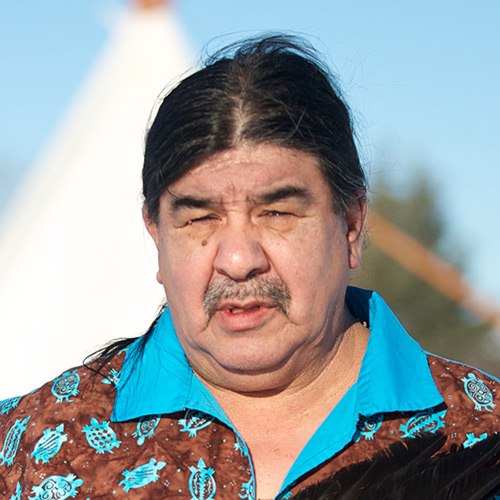
“To me, it means it’s a place where the spirit lives, where there’s light, where it’s progressive, forward thinking. You walk into the building and you feel the energy there. It’s so positive and it represents new beginnings and forward-thinking ideas that were not thought of before. Everything Indigenous people would have wanted done for this building has been done. All the material that could have been used from the old building was reused, it’s run by the sun. It epitomizes the Indigenous community here in Manitoba.”
Miss Una Swan, Black Eagle Woman, Fisher River Cree Nation Elder
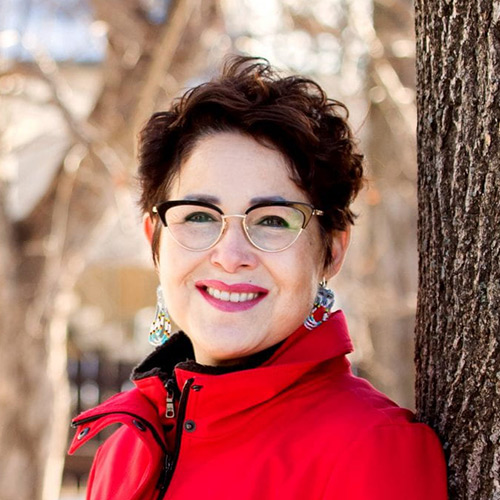
The name is in Anishinaabemowin (Ojibwe), Elder Paul Guimond’s language and one of the most common languages in Treaty No. 1, alongside Inninew, Michif, Dakota, Dené, and Inuktitut.
The name Manitou a bi Bii daziigae translates to Where Creator sits (Manitou a bi) and Brings light (Bii daziigae).
The first part of the name, Manitou a bi, signifies the importance of where the building is in Winnipeg, Manitoba, in Treaty No 1. The meaning of “where Creator sits” has a few reasons for its deeper meaning by honouring the unique history of how Indigenous peoples came to meet and gather in the Winnipeg area on the converging rivers, as well as a representation of the diverse cultures and spiritually of Indigenous peoples. It’s our home. It drives innovation and leadership from the centre outward.
The second part of the name, Bii daziigae, describes the purpose, intent, functionality, and beauty of the new space. “Brings the light” is about the building’s aim to bring students, staff, community and business together to collaborate, develop new ideas, solve problems, future think, and utilize and create the newest technology. It signifies bringing in a new era of hope with the renewed commitment to pursuing Truth and Reconciliation in everything at RRC Polytech. It also represents the building’s solar energy and sustainability efforts—the natural light that pours through the many windows and main open agora inspired the Elders.
“Manitou a bi Bii daziigae, a place where the Creator sits to that place that brings light. It’s a very spiritual name. We have to have faith; we have to believe that it’s in the spirit of that name that we’re going to we’re going to be guided. Reconciliation is going to be happening in that in that space without even knowing it.”
Elder Paul Guimond
“There’s just so many things that this word encompasses. The first part and the second part; it’s not just the name, it’s what those words represent. It represents all of those good, positive things. It also represents truth and reconciliation era that we’re in right now. It’s a building that really honours the Indigenous community of this territory and everything that any Indigenous leaders and community people have always wanted has been done with this building.”
Miss Una Swan
Elder Paul Guimond, Okonace (Little Eagle Bone), from Sagkeeng First Nation, and Miss Una Swan, Black Eagle Woman, from Fisher River Cree Nation, were approached and offered tobacco in the spirit of reciprocity to begin a traditional naming process for the newest building at the Exchange District Campus. The new name would represent the beginning of a new era and would reflect the history and the community where the building stands.
Many Elders and Knowledge Keepers not only carry the living histories, teachings and stories of their ancestors, but in many different ways, act as a gateway between other worlds as they seek guidance for what is asked of them through their spiritual relationships.
Indigenous knowledge, teachings and traditions were prioritized in the design and creation of the building to ensure Indigenous students, staff and community were represented through art by Anishinabee artist Jackie Traverse and Cree/British artist KC Adams and more; functionality for ceremony with ventilated spaces, including the 210-seat Roundhouse Auditorium; and the intention for inclusive spaces to connect and collaborate. Elders provided critical consultation for many aspects and designs of the new building.
The Elders also advised the development of the new strategic plan for 2022-2026, In Front of What’s Ahead, specifically Commitment 2: Commit to Truth and Reconciliation. Pursue Equity, Diversity, and Inclusion in everything we do.
Both Elders utilized their own traditional ceremonial protocols for this process as their teachings instruct, given to them by their Elders and Spiritual Guides. Elders and Knowledge Keepers have obligations to the teachings they’ve received, to their Elders and communities, their ancestors, and spirit itself.
When asking for something such as a name, the spirit of reciprocity is honoured through what can be offered to Creator, including, but not limited to, time, sacrifice, and ceremony.
Elder Paul is a Sun Dance Chief. He leads this four-day ceremony in his home community every summer. During this time period, he prayed on the new name. The name that came to him was confirmed for him upon visiting the building. He too knew the significance of the name would provide life for the building.
“Words are not enough for us. We sacrifice. We give thanks. The only way that we know how and this is to give something up that we have control over and to give up our comfort just so that we can show the Creator, we mean thanks. I don’t think we say thank you enough as a people.
And, you know, our people have been very generous. Our people have been really sharing. We never put ownership on anything. Other than to share. Because we don’t own anything.”
Elder Paul Guimond
In her quest for the name, Miss Una asked for guidance and direction during a fasting ceremony where she gave up food and water for three days and three nights while surrounded by nature. During this time, she prayed and sought direction, asking for the name that would reflect the building’s purpose. The name that was revealed to her had deep significance for its purpose.
“I have to give up something. So I gave up food and water for the three days and asked for the name. And then it came to me and I knew it was the name because it wouldn’t go away. It just kept coming. It was just a repeat in my mind that this was the name when I was done the fast.
I think it’s really important to have that name and to make that sacrifice, to take that time, to make sure the name is right because once it’s named, it’s there for forever. So it was a serious task that I was given, as well as Elder Paul.”
Miss Una Swan
Twice a year during spring and fall solstice, the name will be honoured and celebrated so it continues to guide and direct all who enter the building in a good way.
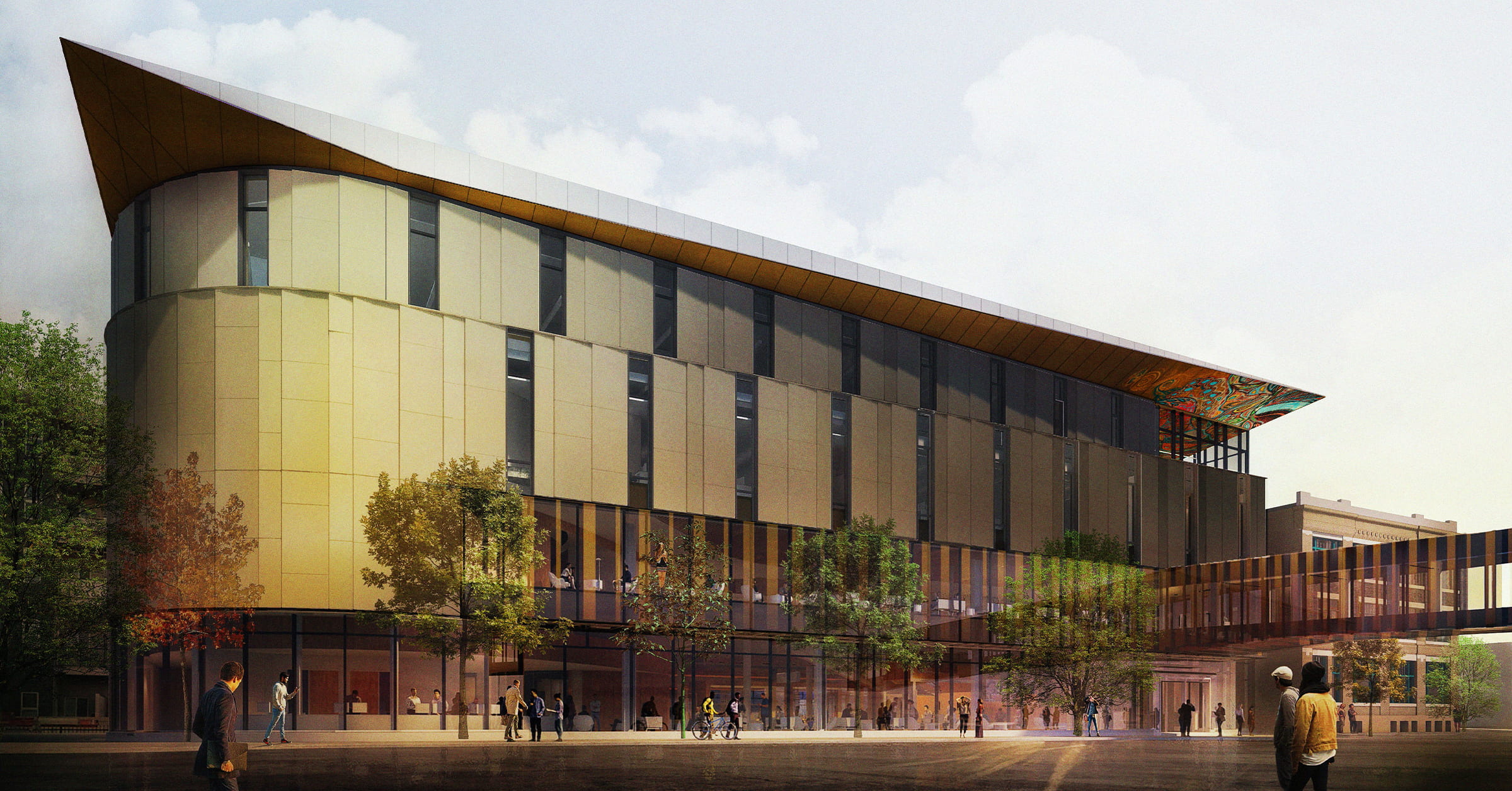
The name was introduced through a pipe ceremony during the official opening in the public agora for the new 100,000 square-foot space to bring spirit and life to the name, so spirit recognizes that name, honour traditional sacred ceremony and so the building will be a sacred space for students, staff and community to learn and connect.
Both Elders were given tours of the building to help them inform an appropriate name.
Manitou a bi Bii daziigae houses an atmosphere of constant innovation that focuses on creative arts, technology, Indigenous entrepreneurship and social innovation, and industry-led applied research. Students, faculty, industry mentors and members of the community will use this dynamic space to engage in concept development, product development, testing, and promotion – creating solutions to real-world issues that benefit the lives of Manitobans.
The building features prominent art from Anishinaabe artist Jackie Traverse and Cree/British artist KC Adams, both of which include layers of symbolism of Indigenous culture, history, and ceremony. These works of art will hopefully provide representation and inspiration for Indigenous learners and community members.
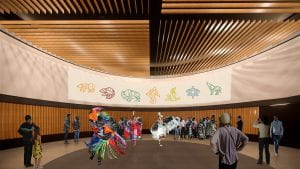
The Roundhouse Auditorium is a 210-seat space that is available for interactive lectures, traditional teachings, ceremonies and large events. The Roundhouse and the round meeting room below it are fully ventilated and allow for the use of sacred medicines. KC Adams’ Morning Star design (created using birchbark technology) is embedded into the floor in this space.
“When we were conversing with the architects and the engineers, they really considered a lot before construction and I thought it was like a vision quest. The way that they were talking, you know, it sounded like a vision quest. How they took into account the influence of nature and the impacts of nature. I thought that was so beautiful. And while we were there, it happened to be a nice, sunny day and there was the warmth of the sun in that space.”
Elder Paul Guimond
“I thought that it represented transparency because there’s so many windows in the building where you can see other areas. It’s wide open and there’s four levels, which speaks to me because of the four directions and then they have two rooms that are round and ventilated so that we can invite people to have ceremonies or have drum practice and things like that. So we really want to enjoy it, invite the community into the building and making it a community place. Not to mention all of the partnerships all around the world that have gone into this building. It’s there’s just so many things that this word encompasses those. The first part and the second part is not just the name, it’s what those words represent. It represents all of those good, positive things.
It also represents truth and reconciliation era that we’re in right now. It’s a building that really honours the Indigenous community of this territory and everything that any indigenous leaders and community people have always wanted has been done with this building.”
Miss Una Swan
The building is designed as a hub for technology, collaboration and community. Programs housed in the space have been developed in consultation with Manitoba’s fastest-growing industries. The building also includes new meeting spaces, classrooms and testing rooms for the College’s Language Training Centre and ACE Project Space – creating more opportunities for a connected learning experience.
In total there are 18 classrooms and five labs in the new building, including the following specialized spaces:
Manitou a bi Bii daziigae is on track to be RRC Polytech’s fourth LEED-certified building, with a goal of 100 energy use intensity and a near net zero efficiency.
Part of Manitou a bi Bii daziigae’s design includes Building Integrated Photovoltaics (BIPV) that have been installed along the exterior. Designed by SwissINSO, the coloured panels — called Kromatix — absorb and conduct energy while also protecting the building from the elements. This installation is the first of its kind in Canada, and will reduce energy consumption by an estimated 15 per cent.
Thanks to energy efficient technologies — including Power Over Ethernet lighting, Smart LSI Breakers, Wi-Fi outlets and BIPVs — the renewable energy produced will also power the building.
The Elgin Avenue Plaza – nestled between the Roblin Centre and the new building – is a greenspace and pedestrian plaza for students, staff and community members. The outdoor space includes seating areas, recreational space, and power outlets for food trucks, entertainment and vendors.
Students and community members can use the space to study, eat lunch, or host events such as concerts or maker markets. The greenspace is located across from the new Market Lands, a creative hub, housing and market space that will attract more people to live, work and play in the growing neighbourhood.
RRC Polytech campuses are located on the lands of Anishinaabe, Ininiwak, Anishininew, Dakota, and Dené, and the National Homeland of the Red River Métis.
We recognize and honour Treaty 3 Territory Shoal Lake 40 First Nation, the source of Winnipeg’s clean drinking water. In addition, we acknowledge Treaty Territories which provide us with access to electricity we use in both our personal and professional lives.